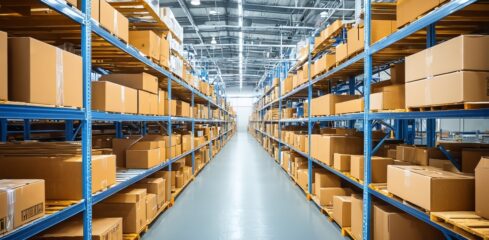Commercial businesses — including warehouses — accounted for 12% of the United State’s total energy consumption in 2019, consuming 9.4 quadrillion Btu. Non-refrigerated warehouses consume an average of 6.1 kilowatt-hours of electricity per square foot each year. All this energy consumption adds up, cutting into a warehouse’s bottom line. As a warehouse or logistics manager, you must balance minimizing your facility’s energy costs while maintaining efficient daily operations without interruptions.
Here are five ideas to save energy costs in warehouses and how Finale Inventory can help you maximize your profits.
Main Contributors to High Energy Bills for Warehouses
Lighting, commercial refrigeration, ventilation and cooling systems are the largest energy consumers in commercial buildings across the U.S, including warehouses of all sizes and industries.
Check your facility for these common offenders:
- Idling or outdated machinery and equipment.
- Energy-draining overhead lighting.
- Old or inefficient HVAC systems.
- Inadequate building insulation.
- Lack of money-saving sustainability initiatives.
You may also see increased energy costs for warehouses if you haven’t yet automated your logistics or created a plan of action to identify and correct excess consumption.

Best Ways to Save Energy Costs in a Warehouse
Reducing your energy consumption is simple once you identify areas for improvement. These are five ways to minimize warehouse energy use that won’t disrupt your daily operations.
1. Make Operational Changes
Small changes to your operations can make a significant difference over time, including:
- Avoid machine idle: Fully shut down machines, tools and equipment when you’re not using them instead of letting them idle and consume unnecessary energy.
- Invest in automated equipment: Look for equipment and machinery with automatic shut-off settings or built-in smart technology to sense when your machine is idling. Some systems can also alert you if your equipment is consuming more energy than usual, indicating an error. Choose energy-efficient settings when possible.
- Service and maintain machines: All machines require regular maintenance and servicing for efficient operation. Update or replace outdated components — including filters, belts, bearings and system software — and contact a professional repair service if things are running slower than normal.
2. Take Advantage of Green Energy Savings
Going green is good for the environment, and it’s one of the best ways to save warehouse energy costs. Some businesses may even qualify for state and federal incentives, like tax breaks or grants, for maintaining a green facility.
Implement formal green energy processes and upgrades in these areas to keep your consumption low:
- Lighting: Lighting is the largest energy consumer in commercial buildings. Replace outdated lighting systems with energy-efficient LED bulbs — dimmable bulbs are the best — which last a long time and won’t generate heat that may cause an additional energy spike. Work with a professional to implement bi-level switching throughout your facility, which gives you separated control over different areas of your lighting so you can choose which parts of your warehouse to light and when. Achieve even greater energy efficiency by investing in natural skylights for daytime shifts.
- Insulation: Ensure proper wall, door and window insulation to keep warm and cool air indoors and reduce energy waste. Note gaps between window sills or door frames and repair cracks or holes.
- Sustainability: Sustainability means choosing processes that create minimal waste and environmental impact while leading to long-term savings. In your warehouse, this means choosing lightweight, biodegradable packaging materials that you can reuse. Use cloud-based electronic barcode and order systems instead of paper documents, which cost money to produce and are prone to damage or loss. Establish a facility-wide recycling and reuse program. Consider supplementing some of your energy consumption with solar energy panels.
3. Have Your HVAC Inspected
Outdated or damaged HVAC systems can be costly. Set a reminder to inspect and change your filters monthly or as recommended by the manufacturer. Schedule regular HVAC system inspections and routine maintenance.
Older systems also lack modern features and technology to be very energy efficient. Look for a programmable system, so you can customize the temperature according to the day and time — you can save as much as 10% on HVAC-related costs by setting your system to a higher or lower temperature, depending on the season, for a few hours daily.
4. Implement Flexible Scheduling
Though not possible for every warehouse, some facilities will benefit from flexible scheduling for employees and work tasks. For example, you could shift wintertime hours of operation to take place during the warmest part of the day, rather than early in the morning or late at night, to save on heating costs. Reverse the schedule during the hot summer months. If you have skylights installed, plan shifts to align with daylight hours and keep some overhead lights off for longer.
5. Get Help With Warehouse Logistics
An outside expert can take a closer look at your warehouse logistics and identify areas for further improvement and cost savings. Automated management software can help track important data and trends, like which items move quickly and which sit on the shelves longer, costing you more in storage and other resources. You can use this information to streamline your operations and make adjustments to continue lowering costs.

Logistics Solutions for Businesses to Lower Warehouse Costs
Finale Inventory management can help you automate your warehouse processes, track goals with key performance indicators and use forecasting analytics to make money-saving decisions. Our cloud-based software is ideal for high-volume, multi-channel warehouses and includes features like:
- Centralized inventory control with real-time information about stock levels.
- Purchasing and replenishing order management.
- Mobile barcode scanning and label printing.
- Order picking and stock transfers.
- Accounting metrics.
- Integration with more than 40 third-party platforms, including QuickBooks.
Inventory management can help you make smarter merchandising decisions that save space around your facility and avoid costly accidents and material or product waste. Automated processes reduce the likelihood of expensive human errors, like stock miscounts. They can also help you stay in-budget, with accurate inventory levels that prevent overordering and keep your clients happy. Automate manual tasks, like administrative records and purchase orders, and put them on our secure cloud-based system to avoid downtime and data loss.
How Finale Inventory Can Help
Leading businesses around the world rely on Finale Inventory for inventory management. No matter what size warehouse you operate, every account gets a dedicated customer relationship manager to help you get the most out of your new software and provide training and customization as needed. Our plans are low-commitment and highly scalable to suit your ever-changing business needs. By investing in inventory management software, you also equip your employees with the tools and insight they need to succeed, creating a more positive and productive work environment.

Request a Finale Inventory Demo
Just a few changes to your operations, equipment and processes can lead to significant energy savings for your warehouse. See for yourself how Finale Inventory can help you manage your warehouse energy consumption and reduce overspending — request a free demo today!






